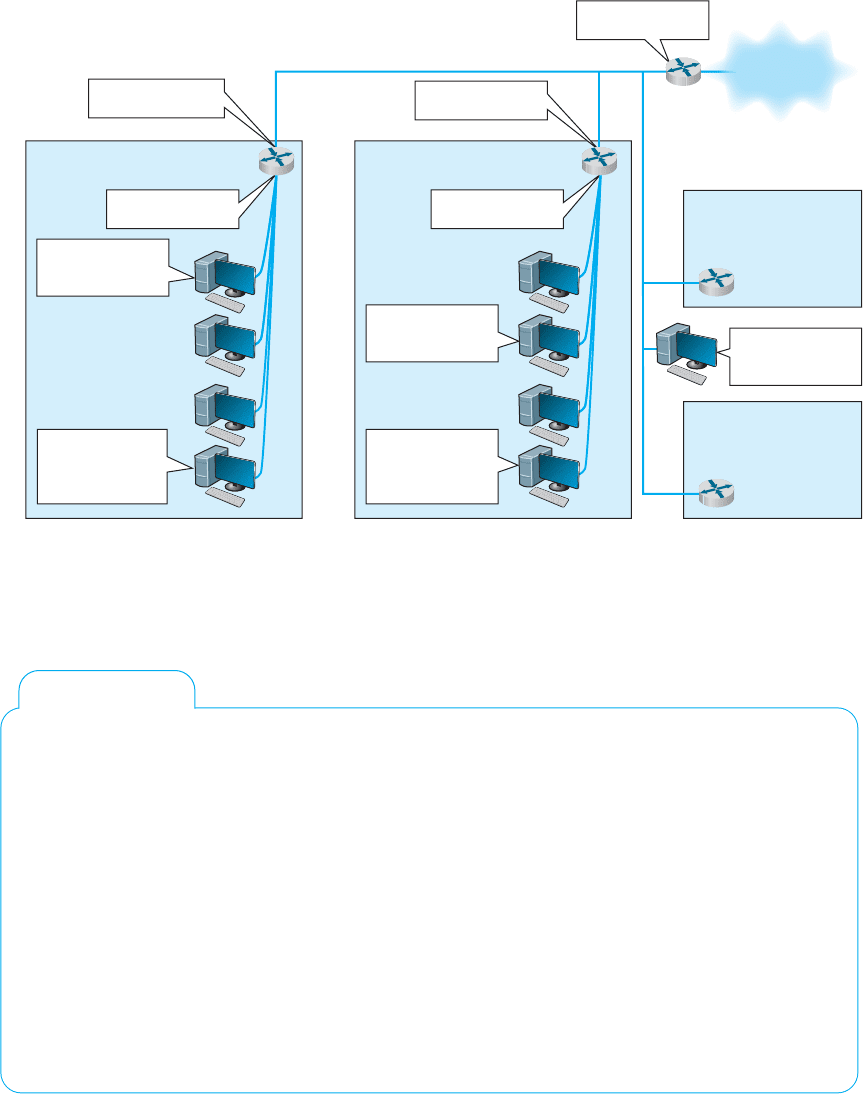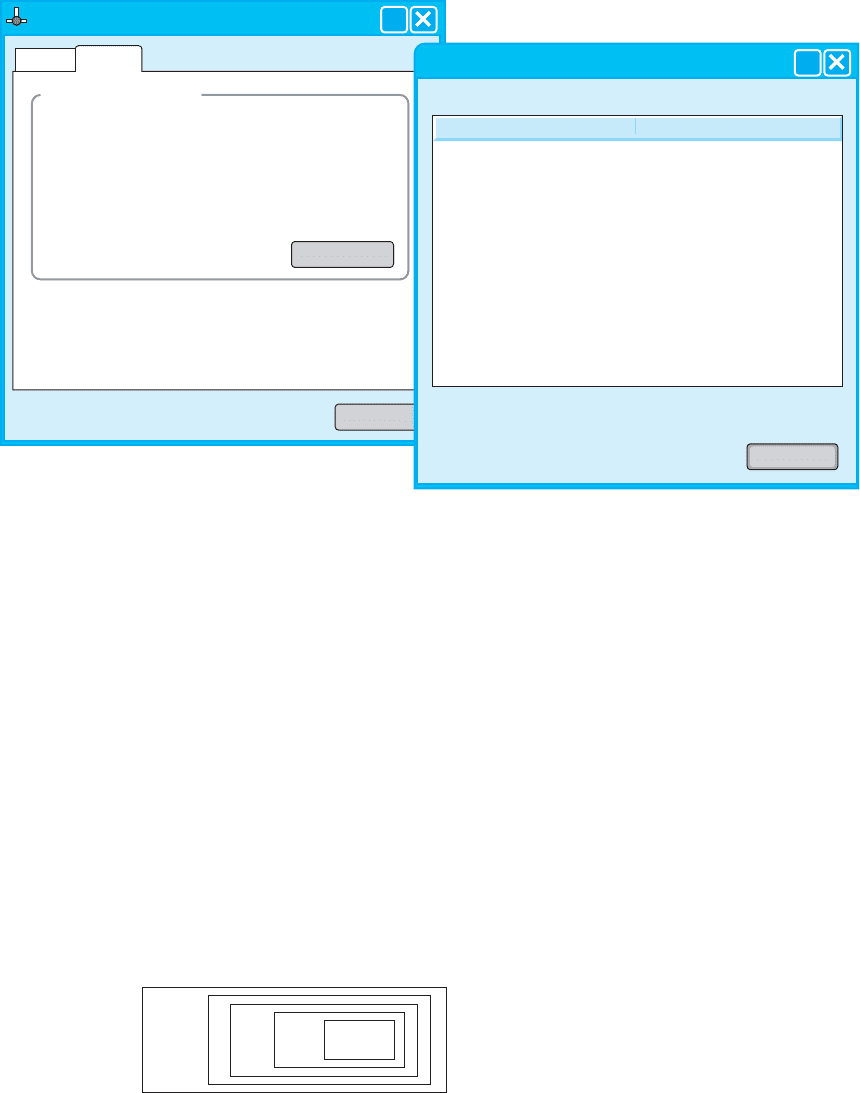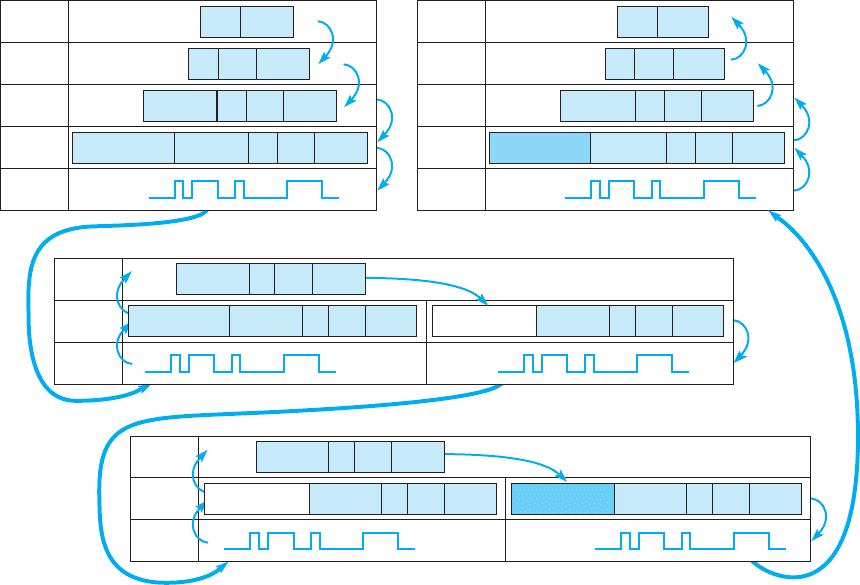FitzGerald J., Dennis A., Durcikova A. Business Data Communications and Networking
Подождите немного. Документ загружается.


5.6 TCP/IP EXAMPLE 175
128.192.98.1
00-0C-00-33-3A-0B
Building A
(128.192.98.X)
Client
Client
128.198.254.3
00-0C-00-33-3A-BB
128.192.95.5
00-0C-00-33-3A-B4
Router
Router
Building B
(128.192.95.X)
Building C
(128.192.50.X)
Backbone
(128.192.254.X)
128.192.254.5
00-0C-00-33-3A-AF
128.192.254.7
00-0C-00-33-3A-0C
Client
128.192.95.32
00-0C-00-33-3A-1B
DNS server
128.192.254.4
00-0C-00-33-3A-0D
Web server
www2.anyorg.com
128.192.95.30
00-0C-00-33-3A-A0
Building D
(128.192.75.X)
Router
Client
128.192.98.130
00-0C-00-33-3A-A3
Web server
www1.anyorg.com
128.192.98.53
00-0C-00-33-3A-F2
Router
Router
Internet
FIGURE 5.13 Example Transmission Control Protocol/Internet Protocol (TCP/IP)
network
5.3
FINDING Y OUR COMPUTER’S
TCP/IP SETTINGS
TECHNICAL
FOCUS
If your computer can access the Internet, it must use
TCP/IP. In Windows, you can find out your TCP/IP
settings by looking at their
properties.
Click on the
Start
button and then select
Control Panel
and then
select
Network Connections.
Double click on your
Local Area Connection
andthenclickthe
Support
tab.
This will show you your computer’s IP address,
subnet mask, and gateway, and whether the IP
address is assigned by a DHCP server. Figure 5.14
shows this information for one of our computers.
If you would like more information, you can click
on the
Details
button. This second window shows
the same information, plus the computer’s Ether-
net address (called the physical address), as well
as information about the DHCP lease and the DNS
servers available.
Try this on your computer. If you have your
own home network with your own router, there is
a chance that your computer has an IP address very
similar to ours or someone else’s in your class—or
the same address, in fact. How can two computers
have the same IP address? Well, they can’t. This is
a security technique called
network address trans-
lation
in which one set of ‘‘private’’ IP addresses is
used inside a network and a different set of ‘‘public’’
IP addresses is used by the router when it sends
the messages onto the Internet. Network address
translation is described in detail in Chapter 11.

176 CHAPTER 5 NETWORK AND TRANSPORT LAYERS
Close
General
Local Area Connection Status
Support
Details...
Internal Protocol (TCP/IP)
Address Type:
IP Address:
Subnet Mask:
Default Gateway:
Assigned by DHCP
192.168.1.100
255.255.255.0
192.168.1.1
?
Close
Network Connection Details:
Nework Connection Detailst
Property
Physical Address
IP Address
Subnet Mask
Default Gateway
DHCP Server
Lease Obtained
Lease Expires
DNS Servers
WINS Server
00-B0-D0-F7-B8-F4
192.168.1.100
255.255.55.0
192.168.1.1
192.168.1.1
10/29/2003 7:05:19 AM
11/4/2003 7:05:19 AM
24.12.70.15
24.12.70.17
63.240.76.4
Value
?
FIGURE 5.14 TCP/IP configuration information
server, so the addresses are in its address tables). Because the application layer software
knows the IP address of the server, it uses its IP address, not its application layer address.
In this case, the application layer software (i.e., Web browser) passes an HTTP
packet containing the user request to the transport layer software requesting a page
from 128.192.98.53. The transport layer software (TCP) would take the HTTP packet,
add a TCP segment, and then hand it to the network layer software (IP). The network
layer software will compare the destination address (128.192.98.53) to the subnet mask
(255.255.255.0) and discover that this computer is on its own subnet. The network layer
software will then search its data link layer address table and find the matching data link
layer address (00-0C-00-33-3A-F2). The network layer would then attach an IP packet
and pass it to the data link layer, along with the destination Ethernet address. The data
link layer would surround the frame with an Ethernet frame and transmit it over the
physical layer to the Web server (Figure 5.15).
The data link layer on the Web server would perform error checking before passing
the HTTP packet with the TCP segment and IP packet attached to its network layer
software. The network layer software (IP) would then process the IP packet, see that it
was destined to this computer, and pass it to the transport layer software (TCP). This
Ethernet IP TCP RequestHTTP
FIGURE 5.15 Packet nesting. HTTP =
Hypertext Transfer Protocol; IP = Internet Protocol;
TCP = Transmission Control Protocol
5.6 TCP/IP EXAMPLE 177
software would process the TCP segment, see that there was only one packet, and pass
the HTTP packet to the Web server software.
The Web server software would find the page requested, attach an HTTP packet,
and pass it to its transport layer software. The transport layer software (TCP) would
break the Web page into several smaller segment, each less than 1,500 bytes in length,
and attach a TCP segment (with a number to indicate the order) to each. Each smaller
segment would then go to the network layer software, get an IP packet attached that
specified the IP address of the requesting client (128.192.98.130), and be given to the
data link layer with the client’s Ethernet address (00-0C-00-33-3A-A3) for transmission.
The data link layer on the server would transmit the frames in the order in which the
network layer passed them to it.
The client’s data link layer software would receive the frames, perform error check-
ing, and pass the IP packets inside them to the network layer. The network layer software
(IP) would check to see that the packets were destined for this computer and pass the
TCP segments they contained to the transport layer software. The transport layer soft-
ware (TCP) would assemble the separate segments, in order, back into one Web page,
and pass the HTTP packet in turn to the Web browser to display on the screen.
5.6.2 Known Addresses, Different Subnet
Suppose this time that the same client computer wanted to get a Web page from a Web
server located somewhere in Building B (www2.anyorg.com). Again, assume that all
addresses are known and are in the address tables of all computers. In this case, the
application layer software would pass an HTTP packet to the transport layer software
(TCP) with the Internet address of the destination www2.anyorg.com: 128.192.95.30.
The transport layer software (TCP) would make sure that the request fit in one segment
and hand it to the network layer. The network layer software (IP) would then check the
subnet mask and would recognize that the Web server is located outside of its subnet.
Any messages going outside the subnet must be sent to the router (128.192.98.1), whose
job it is to process the message and send the message on its way into the outside network.
The network layer software would check its address table and find the Ethernet address
for the router. It would therefore set the data link layer address to the router’s Ethernet
address on this subnet (00-0C-00-33-3A-0B) and pass the IP packet to the data link layer
for transmission. The data link layer would add the Ethernet frame and pass it to the
physical layer for transmission.
The router would receive the message and its data link layer would perform error
checking and send an acknowledgement before passing the packet to the network layer
software (IP). The network layer software would read the IP address to determine the
final destination. The router would recognize that this address (128.192.95.30) needed to
be sent to the 128.192.95.x subnet. It knows the router for this subnet is 128.192.254.5.
It would pass the packet back to its data link layer, giving the Ethernet address of the
router (00-0C-00-33-3A-AF).
This router would receive the message (do error checking, etc.) and read the IP
address to determine the final destination. The router would recognize that this address
(128.192.95.30) was inside its 128.192.95.x subnet and would search its data link layer
178 CHAPTER 5 NETWORK AND TRANSPORT LAYERS
address table for this computer. It would then pass the packet to the data link layer along
with the Ethernet address (00-0C-00-33-3A-A0) for transmission.
The www2.anyorg.com web server would receive the message and process it.
This would result in a series of TCP/IP packets addressed to the requesting client
(128.192.98.130). These would make their way through the network in reverse order. The
Web server would recognize that this IP address is outside its subnet and would send the
message to the 128.192.95.5 router using its Ethernet address (00-0C-00-33-3A-B4).
This router would then send the message to the router for the 128.192.98.x subnet
(128.192.254.3) using its Ethernet address (00-0C-00-33-3A-BB). This router would in
turn send the message back to the client (128.192.98.130) using its Ethernet address
(00-0C-00-33-3A-A3).
This process would work in the same way for Web servers located outside the
organization on the Internet. In this case, the message would go from the client to the
128.192.98.x router, which would send it to the Internet router (128.192.254.7), which
would send it to its Internet connection. The message would be routed through the
Internet, from router to router until it reached its destination. Then the process would
work in reverse to return the requested page.
5.6.3 Unknown Addresses
Let’s return to the simplest case (requesting a Web page from a Web server on the
same subnet), only this time we will assume that the client computer does not know
the network layer or data link layer address of the Web server. For simplicity, we will
assume that the client knows the data link layer address of its subnet router, but after
you read through this example, you will realize that obtaining the data link layer address
of the subnet router is straightforward. (It is done the same way as the client obtains the
data link layer address of the Web server.)
Suppose the client computer in Building A (128.192.98.130) wants to retrieve a
Web page from the www1.anyorg.com Web server but does not know its addresses. The
Web browser realizes that it does not know the IP address after searching its IP address
table and not finding a matching entry. Therefore, it issues a DNS request to the name
server (128.192.254.4). The DNS request is passed to the transport layer (TCP), which
attaches a UDP datagram and hands the message to the network layer.
Using its subnet mask, the network layer (IP) will recognize that the DNS server
is outside of its subnet. It will attach an IP packet and set the data link layer address to
its router’s address.
The router will process the message and recognize that the 128.192.254.4 IP address
is on the BN. It will transmit the packet using the DNS server’s Ethernet address.
The name server will process the DNS request and send the matching IP address
back to the client via the 128.198.98.x subnet router.
The IP address for the desired computer makes its way back to the application
layer software, which stores it in its IP table. It then issues the HTTP request using
the IP address for the Web server (128.192.98.53) and passes it to the transport layer,
which in turn passes it to the network layer. The network layer uses its subnet mask
and recognizes that this computer is on its subnet. However, it does not know the Web
server’s Ethernet address. Therefore, it broadcasts an ARP request to all computers on
5.6 TCP/IP EXAMPLE 179
its subnet, requesting that the computer whose IP address is 128.192.98.53 to respond
with its Ethernet address.
This request is processed by all computers on the subnet, but only the Web server
responds with an ARP packet giving its Ethernet address. The network layer software
on the client stores this address in its data link layer address table and sends the original
Web request to the Web server using its Ethernet address.
This process works the same for a Web server outside the subnet, whether in the
same organization or anywhere on the Internet. If the Web server is far away (e.g.,
Australia), the process will likely involve searching more than one name server, but it is
still the same process.
5.6.4 TCP Connections
Whenever a computer transmits data to another computer, it must choose whether to
use a connection-oriented service via TCP or a connectionless service via UDP. Most
application layer software such as Web browsers (HTTP), email (SMTP), FTP, and
Telnet use connection-oriented services. This means that before the first packet is sent,
the transport layer first sends a SYN segment to establish a session. Once the session is
established, then the data packets begin to flow. Once the data are finished, the session
is closed with a FIN segment.
In the preceding examples, this means that the first packet sent is really a SYN
segment, followed by a response from the receiver accepting the connection, and then the
packets as described above. There is nothing magical about the SYN and FIN segments,
they are addressed and routed in the same manner as any other packets. But they do add
to the complexity and length of the example.
A special word is needed about HTTP packets. When HTTP was first developed,
Web browsers opened a separate TCP session for each HTTP request. That is, when they
requested a page, they would open a session, send the single packet requesting the Web
page, and close the session at their end. The Web server would open a session, send as
many packets as needed to transmit the requested page, and then close the session. If the
page included graphic images, the Web browser would open and close a separate session
for each request. This requirement to open and close sessions for each request was time
consuming and not really necessary. With the newest version of HTTP, Web browsers
open one session when they first issue an HTTP request and leave that session open for
all subsequent HTTP requests to the same server.
5.6.5 TCP/IP and Network Layers
In closing this chapter, we want to return to the layers in the network model and take
another look at how messages flow through the layers. Figure 5.16 shows how a Web
request message from a client computer in Building A would flow through the network
layers in the different computers and devices on its way to the server in Building B.
The message starts at the application layer of the sending computer (the client in
Building A), shown in the upper left corner of the figure, which generates an HTTP
packet. This packet is passed to the transport layer, which surrounds the HTTP packet
with a TCP segment. This is then passed to the network layer, which surrounds it with

180 CHAPTER 5 NETWORK AND TRANSPORT LAYERS
HTTP Request
Application
Layer
HTTP
TCP
Request
HTTPTCP
IP
128.192.95.30
Request
HTTPTCP
IP
128.192.95.30
Ethernet
00-0C-00-33-3A-A0
Request
Transport
Layer
Network
Layer
Data Link
Layer
Physical
Layer
HTTP
Request
Application
Layer
Sender (Client in Building A)
Gateway (Router in Building A)
HTTPTCP
Request
HTTPTCP
IP
128.192.95.30
Request
HTTPTCP
IP
128.192.95.30
Ethernet
00-0C-00-33-3A-0B
Request
Transport
Layer
Network
Layer
Data Link
Layer
Physical
Layer
Network
Layer
Data Link
Layer
Physical
Layer
HTTPTCP
IP
128.192.95.30
HTTPTCP
IP
128.192.95.30
Ethernet
00-0C-00-33-3A-0B
Request HTTP
TCP
IP
128.192.95.30
Ethernet
00-0C-00-33-3A-AF
Request
Gateway (Router in Building B)
HTTPTCP
IP
128.192.95.30
HTTPTCP
IP
128.192.95.30
Request
Network
Layer
Data Link
Layer
Physical
Layer
HTTPTCP
IP
128.192.95.30
Request
Receiver (Server in Building B)
Request
Request
Ethernet
00-0C-00-33-3A-AF
Ethernet
00-0C-00-33-3A-A0
FIGURE 5.16 How messages move through the network layers
Note: The addresses in this example are destination addresses
an IP frame that includes the IP address of the final destination (128.192.95.30). This in
turn is passed to the data link layer, which surrounds it within an Ethernet frame that
also includes the Ethernet address of the next computer to which the message will be
sent (00-0C-00-33-3A-0B). Finally, this is passed to the physical layer, which converts
it into electrical impulses for transmission through the cable to its next stop—the router
that serves as the gateway in Building A.
When the message arrives at the router in Building A, its physical layer translates
it from electrical impulses into digital data and passes the Ethernet frame to the data link
layer. The data link layer checks to make sure that the Ethernet frame is addressed to the
router, performs error detection, strips off the Ethernet frame, and passes its contents (the
IP packet) to the network layer. The routing software running at the network layer looks
at the destination IP address, determines the next computer to which the packet should
be sent, and passes the outgoing packet down to the data link layer for transmission.
The data link layer surrounds the IP packet with a completely new Ethernet frame that
contains the destination address of the next computer to which the packet will be sent
(00-0C-00-33-3A-AF). In Figure 5.16, this new frame is shown in a different color. This
is then passed to the physical layer, which transmits it through the network cable to its
next stop—the router that serves as the gateway in Building B.

5.6 TCP/IP EXAMPLE 181
When the message arrives at the router in Building B, it goes through the same
process. The physical layer passes the incoming packet to the data link layer, which
checks the destination Ethernet address, performs error detection, strips off the Ethernet
frame, and passes the IP packet to the network layer software. The software deter-
mines the next destination and passes the IP packet back to the data link layer, which
adds a completely new Ethernet frame with the destination address of its next stop
(00-0C-00-33-3A-A0)—its final destination.
The physical layer at the server receives the incoming packet and passes it to the
data link layer, which checks the Ethernet address, performs error detection, removes
the Ethernet frame, and passes the IP packet to the network layer. The network layer
examines the final destination IP address on the incoming packet and recognizes that the
server is the final destination. It strips off the IP packet and passes the TCP segment
to the transport layer, which in turn strips off the TCP segment and passes the HTTP
packet to the application layer (the We b server software).
There are two important things to remember from this example. First, at all gate-
ways (i.e., routers) along the way, the packet moves through the physical layer and data
link layer up to the network layer, but no higher. The routing software operates at the
network layer, where it selects the next computer to which the packet should be sent,
and passes the packet back down through the data link and physical layers. These three
layers are involved at all computers and devices along the way, but the transport and
application layers are only involved at the sending computer (to create the application
layer packet and the TCP segment) and at the receiving computer (to understand the
TCP segment and process the application layer packet). Inside the TCP/IP network itself,
messages only reach layer three—no higher.
Second, at each stop along the way, the Ethernet frame is removed and a new one
is created. The Ethernet frame lives only long enough to move the message from one
computer to the next and then is destroyed. In contrast, the IP packet and the packets
above it (TCP and application layer) never change while the message is in transit. They
are created and removed only by the original message sender and the final destination.
5.4 PODCASTING
TECHNICAL
FOCUS
Podcasting is the distribution of audio and video files
(e.g., MP3 files) over the Internet. Podcasting uses
a relatively old technology (first developed in 2000),
but became popular with the introduction of Apple’s
iPod.
Podcasting requires two things: the content and
a channel description file that describes the content.
The content is usually MP3 files, audio and/or video.
Creating MP3 files is fairly straightforward—see the
Hands-On Activity in Chapter 3.
The channel description file describes the overall
set of files, called a channel, as well as each individual
MP3 file that is available. This file is an XML file that
is created according to the RSS standard (RSS stands
for Rich Site Summary, RDF Site Summary, or Really
Simple Syndication, depending upon which version
of the standard you read).
Users subscribe to a podcast channel by entering
the URL of the channel description RSS file into
their favorite aggregation software (e.g., iTunes).
The aggregation software regularly reads the RSS
file. When it notices that the RSS file contains a
new entry for a new MP3 file, the software auto-
matically downloads the new content to the user’s
iPod.

182 CHAPTER 5 NETWORK AND TRANSPORT LAYERS
5.7 IMPLICATIONS FOR MANAGEMENT
The implications from this chapter are similar in many ways to the implications from
Chapter 4. There used to be several distinct protocols used at the network and transport
layers but as the Internet has become an important network, most organizations are
moving to the adoption of TCP/IP as the single standard protocol at the transport and
network layers. This is having many of the same effects described in Chapter 4: The cost
of buying and maintaining networking equipment and the cost of training networking staff
is steadily decreasing. However, as we move closer to running out of IPv4 addresses,
more organizations will move to IPv6. This will cost a lot, but most organizations will
see little business value from the change.
As TCP/IP becomes the dominant transport and network layer protocol for digital
data, telephone companies who operate large non-TCP/IP-based networks to carry voice
traffic are beginning to wonder whether they too should make the switch to TCP/IP. This
has significant financial implications for companies that manufacture large networking
equipment used in these networks.
SUMMARY
Transport and Network Layer Protocols TCP/IP are the standard transport and network protocols
used today. They perform addressing (finding destination addresses), routing (finding the “best”
route through the network), and segmenting (breaking large messages into smaller packets for
transmission and reassembling them at the destination).
Transport Layer The transport layer (TCP) uses the source and destination port addresses to link
the application layer software to the network. TCP is also responsible for segmeting—breaking
large messages into smaller segments for transmission and reassembling them at the receiver’s
end. When connection-oriented routing is needed, TCP establishes a connection or session from
the sender to the receiver. When connectionless routing is needed, TCP is replaced with UDP.
Quality of service provides the ability to prioritize packets so t hat real-time voice packets are
transmitted more quickly than simple email messages.
Addressing Computers can have three different addresses: application layer address, network
layer address, and data link layer address. Data link layer addresses are usually part of the hard-
ware, whereas network layer and application layer addresses are set by software. Network layer
and application layer addresses for the Internet are assigned by Internet registrars. Addresses
within one organization are usually assigned so that computers in the same LAN or subnet
have similar addresses, usually with the same first 3 bytes. Subnet masks are used to indi-
cate whether the first 2 or 3 bytes (or partial bytes) indicate the same subnet. Some networks
assign network layer addresses in a configuration file on the client computer whereas others use
dynamic addressing in which a DHCP server assigns addresses when a computer first joins the
network.
Address Resolution Address resolution is the process of translating an application layer address
into a network layer address or translating a network layer address into a data link layer address.
On the Internet, network layer resolution is done by sending a special message to a DNS server
(also called a name server) that asks for the IP address (e.g., 128.192.98.5) for a given Internet
address (e.g., www.kelley.indiana.edu). If a DNS server does not have an entry for the requested
Internet address, it will forward the request to another DNS server that it thinks is likely to have

KEY TERMS 183
the address. That server will either respond or forward the request to another DNS server, and so
on, until the address is found or it becomes clear that the address is unknown. Resolving data link
layer addresses is done by sending an ARP request in a broadcast message to all computers on
the same subnet that asks the computer with the requested IP address to respond with its data link
layer address.
Routing Routing is the process of selecting the route or path through the network that a message
will travel from the sending computer to the receiving computer. With centralized routing, one
computer performs all the routing decisions. With static routing, the routing table is developed by
the network manager and remains unchanged until the network manager updates it. With dynamic
routing, the goal is to improve network performance by routing messages over the fastest possible
route; an initial routing table is developed by the network manager but is continuously updated to
reflect changing network conditions, such as message traffic. BGP, RIP, ICMP, EIGRP, and OSPF
are examples of dynamic routing protocols.
TCP/IP Example In TCP/IP, it is important to remember that the TCP segments and IP packets
are created by the sending computer and never change until the message reaches its final destination.
The IP packet contains the original source and ultimate destination address for the packet. The
sending computer also creates a data link layer frame (e.g., Ethernet) for each message. This
frame contains the data link layer address of the current computer sending the packet and the
data link layer address of the next computer in the route through the network. The data link
layer frame is removed and replaced with a new frame at each computer at which the message
stops as it works its way through the network. Thus, the source and destination data link layer
addresses change at each step along the route whereas the IP source and destination addresses
never change.
KEY TERMS
Access Control List
(ACL)
address resolution
Address Resolution
Protocol (ARP)
addressing
application layer address
autonomous systems
auxiliary port
Border Gateway Protocol
(BGP)
border router
broadcast message
centralized routing
Cisco IOS
classless addressing
connectionless messaging
connection-oriented
messaging
console port
data link layer address
designated router
destination port
address
distance vector dynamic
routing
Domain Name Service
(DNS)
dynamic addressing
Dynamic Host
Configuration Protocol
(DHCP)
dynamic routing
Enhanced Interior
Gateway Routing
Protocol (EIGRP)
exterior routing protocol
gateway
hop
Intermediate System to
Intermediate System
(IS-IS)
Interior Gateway Routing
Protocol (IGRP)
interior routing protocol
Internet address classes
Internet Control Message
Protocol (ICMP)
Internet Corporation for
Assigned Names and
Numbers (ICANN)
Internet Group
Management Protocol
(IGMP)
link state dynamic routing
multicast message
name server
Network Interface port
(TCP/IP port)
network layer address
Open Shortest Path First
(OSPF)
port address
Quality of Service (QoS)
Real-Time Streaming
Protocol (RTSP)
RSS
Real-Time Transport
Protocol (RTP)
Resource Reservation
Protocol (RSVP)
router
routing
Routing Information
Protocol (RIP)
routing table
segment
segmenting
source port address
static routing
subnet
subnet mask
Transmission Control
Protocol/Internet
Protocol (TCP/IP)
unicast message
User Datagram Protocol
(UDP)

184 CHAPTER 5 NETWORK AND TRANSPORT LAYERS
QUESTIONS
1. What does the transport layer do?
2. What does the network layer do?
3. What are the parts of TCP/IP and what do they
do? Who is the primary user of TCP/IP?
4. Compare and contrast the three types of
addresses used in a network.
5. How is TCP different from UDP?
6. How does TCP establish a session?
7. What is a subnet and why do net-
works need them?
8. What is a subnet mask?
9. How does dynamic addressing work?
10. What benefits and problems does dynamic
addressing provide?
11. What is address resolution?
12. How does TCP/IP perform address resolution
from URLs into network layer addresses?
13. How does TCP/IP perform address resolution
from IP addresses into data link l ayer addresses?
14. What is routing?
15. How does decentralized routing differ
from centralized routing?
16. What are the differences between connection-
less and connection-oriented messaging?
17. What is a session?
18. What is QoS routing and why is it useful?
19. Compare and contrast unicast, broadcast,
and multicast messages.
20. Explain how multicasting works.
21. Explain how the client computer in Figure 5.14
(128.192.98.xx) would obtain the data link
layer address of its subnet router.
22. Why does HTTP use TCP and DNS use UDP?
23. How does static routing differ from dynamic
routing? When would you use static routing?
When would you use dynamic routing?
24. What type of routing does a TCP/IP client
use? What type of routing does a TCP/IP
gateway use? Explain.
25. What is the transmission efficiency
of a 10-byte Web request sent using
HTTP, TCP/IP, and Ethernet? Assume
the HTTP packet has 100 bytes in addi-
tion to the 10-byte URL. Hint: Remem-
ber from Chapter 4 that efficiency = user
data/total transmission size.
26. What i s the transmission efficiency of
a 1,000-byte file sent in response to a
Web request HTTP, TCP/IP, and Ether-
net? Assume the HTTP packet has 100
bytes in addition to the 1,000-byte file.
Hint: Remember from Chapter 4 that efficiency
= user data/total transmission size.
27. What is the transmission efficiency of a
5,000-byte file sent in response to a Web
request HTTP, TCP/IP, and Ethernet? Assume
the HTTP packet has 100 bytes in addi-
tion to the 5,000-byte file. Assume that the
maximum packet size is 1,200 bytes. Hint:
Remember from Chapter 4 that efficiency =
user data/total transmission size.
28. Describe the anatomy of a router. How does
a router differ from a computer?
EXERCISES
5-1. Would you recommend dynamic addressing for
your organization? Why?
5-2. Look at your network layer software (either on a
LAN or dial-in) and see what options are set—but
don’t change them! You can do this by using the
RUN command to run winipcfg. How do these
match the fundamental addressing and routing con-
cepts discussed in this chapter?
5-3. Suppose a client computer (128.192.95.32) in
Building B in Figure 5.13 requests a large Web page
from the server in Building A (www1.anyorg.com).
Assume that the client computer has just been
